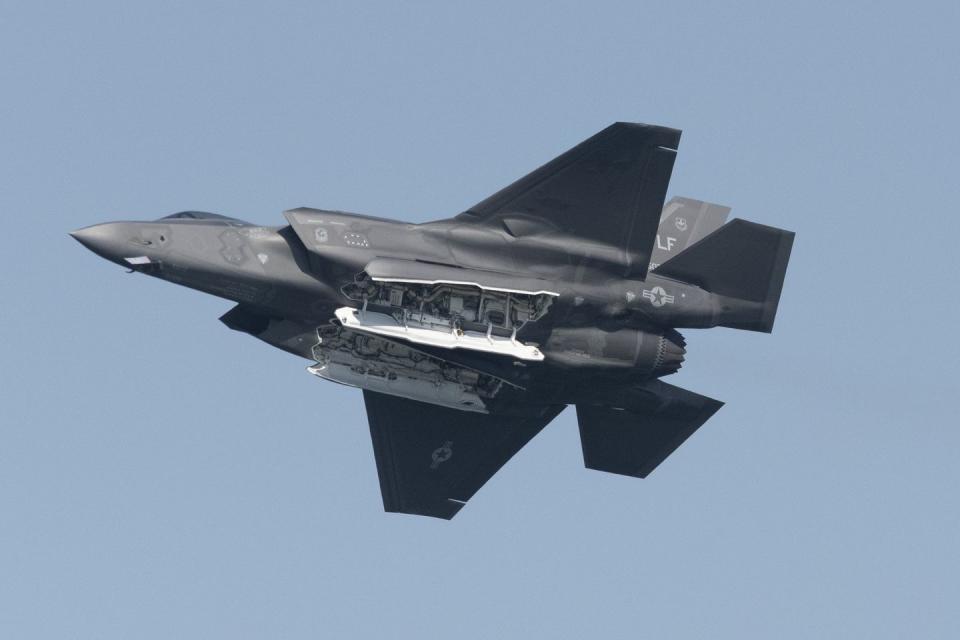The 'Kingsnake' Could Be the Air Force's Next Fighter Jet

The U.S. Air Force has expressed interest in a new, non-stealthy fighter jet to replace the F-16.
Several aviation experts have banded together and invented a new jet out of thin air.
The result, the F-36 Kingsnake, would use the F-22’s engines, place less of an emphasis on stealth, and use digital engineering.
Last month, U.S. Air Force Chief of Staff Gen. C.Q. Brown caused a stir when he announced the service was looking into buying a brand-new fighter jet to help replace the F-16 Viper. Such a jet doesn’t exist—yet—but thanks to new digital engineering techniques, it could actually enter service before 2030.
Now, the alternative aviation magazine Hush-Kit has brought experts together to design that potential F-16 replacement. The result: the F-36 Kingsnake lightweight fighter.
Hush-Kit huddled with aviation authorities Stephen Mcparlin and James Smith, who helped bring aircraft like the F-35 Joint Strike Fighter and Eurofighter Typhoon to life. Then, illustrator Andy Godfrey from the Teasel Studio took their ideas and created this concept art for the F-36:

Hush-Kit used Gen. Brown’s specifications—a lightweight, inexpensive fighter jet that doesn’t emphasize stealth (making it a “fifth-gen-minus” design)—to design the F-36.
The average age of the Air Force’s 783 F-16C fighter jets is 28.7 years, making a 20-year development period for a new jet out of the question. Instead, experts wanted a fast design process that froze the plane’s specs within one year and relied on simple construction techniques, but also utilized advanced technologies such as 3D printing if it could get the fighter off assembly lines faster.
Re-using existing technologies would speed up the process. For example, the F-36 uses the F-22 Raptor’s F119 afterburning turbofan engine to achieve a top speed of Mach 2. The Kingsnake is equipped with an AN/APG-83 advanced electronically scanned array radar— the same one used in the latest version of the F-16—and an infrared sensor system derived from the Legion electro-optical targeting pod.
A “Luddite Czar” would prevent new technologies from creeping into the jet, drawing out the jet’s development time and increasing the likelihood Kingsnake would fall behind.

Like the F-16 it would replace, the Kingsnake would be a multi-role fighter jet capable of air-to-air and air-to-ground missions. The jet would carry missiles and guided bombs in internal bays, but as a non-stealthy plane, it would pack both on wing-mounted external hard points. The Kingsnake would also a gun, making it capable of strafing attacks against enemy ground forces.
The guiding principles behind the F-36 are speed of development, affordability, and the ability to incorporate new tech at a later date. “The F-35 is a Ferrari, the F-22 a Bugatti Chiron—the United States Air Force needs a Nissan 300ZX,” Hush-Kit’s Joe Coles tells Pop Mech.
Could the Air Force build something like the F-36 Kingsnake? Yes. The real question: Will it?
The requirement for a sub-5th generation fighter isn’t set in stone yet, but the Air Force will make up its mind by 2023.
Given that the Air Force recently admitted to designing and building its secret sixth-generation fighter jet in just one year, it could build a plane like the F-36 fairly quickly.

As for the F-36’s name, kingsnakes are North American snakes that live up to 30 years, which bodes well for the F-36’s service life. Kingsnakes are so named because they have a habit of eating other snakes—a fitting moniker for a fighter designed to replace the Viper.
🎥 Now Watch This:
You Might Also Like

